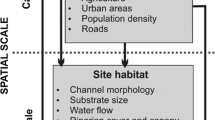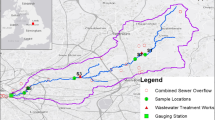Abstract
The EU Water Framework Directive uses abiotic variables for classifying streams and rivers into types. For rivers, the EU Water Framework Directive fixed typology i.e. ‘System A’ typology are defined by ecoregions, size based on the catchment area, catchment geology and altitude. Within any given part of the WFD typology, it is assumed that biological communities at undisturbed sites will be broadly similar and will therefore constitute a type-specific biological target and a way to stratify the spatial variability in stream and river monitoring and assessment. The data collected for the STAR project cover 13 countries and include 22 stream types. A total of 233 sites were fully sampled for all biological quality elements (fish, macrophytes, benthic macroinvertebrates, and diatoms) in the study. Analysing the STAR macroinvertebrate dataset in relation to environmental and biogeographical variables resulted in three major groups of stream types that correspond to three major landscape types in Europe: Mountains, Lowlands and Mediterranean. Similar results were found when analysing all four biological quality elements (fish, macrophytes, benthic macroinvertebrates, and diatoms) sampled in the STAR project. The studies also showed that the stream types using the WFD ‘System A’ descriptors are probably less useful at finer scales and it is suggested that a stream typology should take three main parameters as a starting point, i.e., climate (temperature), slope (current velocity) and stream size. Existing site-specific multivariate RIVPACS-type predictive models were also compared to both null models and the WFD ‘System A’ physical typology as methods of predicting macroinvertebrate reference conditions. It was concluded that the multivariate models are more effective in predicting reference conditions primarily because they make use of continuous rather than categorical predictor variables and because the multivariate RIVPACS-type models are not constrained by the use of a limited number of variables.
Similar content being viewed by others
References
J. Davy-Bowker R. T. Clarke R. K. Johnson J. Kokes J. F. Murphy S. Zahrádková (2006) ArticleTitleA comparison of the European Water Framework Directive physical typology and RIVPACS-type models as alternative methods of establishing reference conditions for benthic macroinvertebrates Hydrobiologia 566 91–105
InstitutionalAuthorNameEuropean Commission (2000) Directive 2000/60/EC. Establishing a framework for community action in the field of water policy European Commission PE-CONS 3639/1/100 Rev 1 Luxembourg
Furse, M., D. Hering, O. Moog, P. Verdonschot, R. K. Johnson, K. Brabec, K. Gritzalis, A. Buffagni, P. Pinto, N. Friberg, J. Murray-Bligh, J. Kokes, R. Alber, P. Usseglio-Polatera, P. Haase, R. Sweeting, B. Bis, K. Szoszkiewicz, H. Soszka, G. Springe, F. Sporka & I. Krno, 2006. The STAR project: context, objectives and approaches. Hydrobiologia 566: 3–29
J. Heino T. Muotka R. Paavola (2003) ArticleTitleDeterminants of macroinvertebrate diversity in headwater streams: regional and local influences Journal of Animal Ecology 72 425–434 Occurrence Handle10.1046/j.1365-2656.2003.00711.x
D. Hering O. Moog L. Sandin P. F. M. Verdonschot (2004) ArticleTitleOverview and application of the AQEM assessment system Hydrobiologia 516 1–20 Occurrence Handle10.1023/B:HYDR.0000025255.70009.a5
J. Illies (1978) Limnofauna Europaea Gustav Fischer Verlag Stuttgart
R. K. Johnson (1998) ArticleTitleSpatiotemporal variability of temperate lake macroinvertebrate communities: detection of impact Ecological Applications 8 61–70 Occurrence Handle10.2307/2641311
J. M. Omernik R. G. Bailey (1997) ArticleTitleDistinguishing between watersheds and ecoregions Journal of the American Water Resources Association 33 935–949
P. Pinto M. Morais M. Ilhéu L. Sandin (2006) ArticleTitleRelationships among biological elements (macrophytes, macroinvertebrates and ichthyofauna) for different core river types across Europe at two different spatial scales Hydrobiologia 566 75–90
T. B. Reynoldson R. H. Norris V. H. Resh K. E. Day D. M. Rosenberg (1997) ArticleTitleThe reference condition: a comparison of multimetric and multivariate approaches to assess water-quality impairment using benthic macroinvertebrates Journal of the North American Benthological Society 16 833–852 Occurrence Handle10.2307/1468175
L. Sandin R. K. Johnson (2000) ArticleTitleEcoregions and benthic macroinvertebrate assemblages of Swedish streams Journal of the North American Benthological Society 19 462–474 Occurrence Handle10.2307/1468107
P. F. M. Verdonschot R. C. Nijboer (2004) ArticleTitleTesting the European stream typology of the water Framework Directive for macroinvertebrates Hydrobiologia 175 35–54 Occurrence Handle10.1023/B:HYDR.0000025257.30311.b7
P. F. M. Verdonschot (2006a) ArticleTitleEvaluation of the use of Water Framework Directive typology descriptors, reference sites, and spatial scale in macroinvertebrate stream typology Hydrobiologia 566 39–58
P. F. M. Verdonschot (2006b) ArticleTitleM. Data composition and taxonomic resolution in macroinvertebrate stream typology Hydrobiologia 566 59–74
J. F. Wright D. Moss P. D. Armitage M. T. Furse (1984) ArticleTitleA prelimnary classification of running-water sites in Great Britain based on macroinvertebrate species and the prediction of community type using environmental data Freshwater Biology 14 221–256 Occurrence Handle10.1111/j.1365-2427.1984.tb00039.x
Wright, J. F., D. W. Sutcliffe & M. T. Furse (eds), 1999. Assessing the biological quality of fresh waters: RIVPACS and other techniques. Freshwater Biological Association, Ambleside, Cumbria, UK. The RIVPACS International Workshop, 16–18 September 1997, Oxford, UK
Author information
Authors and Affiliations
Corresponding author
Rights and permissions
About this article
Cite this article
Sandin, L., Verdonschot, P.F.M. Stream and river typologies – major results and conclusions from the STAR project. Hydrobiologia 566, 33–37 (2006). https://doi.org/10.1007/s10750-006-0072-9
Issue Date:
DOI: https://doi.org/10.1007/s10750-006-0072-9




